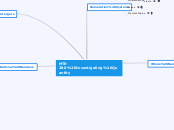MTE-280 Investigating Quantity
Numeration Systems
Different Systems
Number SystemsHindu-ArabicPositionalBase 10Decimal=10Used in the United StatesRoman-Numeralssymbols look like this: IV
aBases
BasesBase 101,2,3,4,5,6,7,8,9,10Base 51,2,3,4,10Base 121,2,3,,4,5,6,7,8,9,X,E,10
aPlace Value
Place ValueDepending on where the digit is placed or positioned defines its valueThe place has a value of 10 times the place to its right
aWhole Number Operations
problem types
Problem Types Addition Addition set modelAddition linear modelSubtraction Subtraction takeaway modelSubtraction missing addend modelSubtraction comparison modelSubtraction linear modelMultiplicationMultiplication:repeated addition set modelMultiplication repeated addition linear modelMultiplication area modelDivison Partition modelMeasurement model
Properties
Closure Property of Multiplication: If you multiply any two whole numbers the product will be a whole number.5*3=15Commutative Property of Multiplication: Changing the order of the factors won't change the product.12*2=2*12Associative Property of Multiplication: Changing the grouping of factors doesn't change the product.(4*2)1=(2*1)4Identity Property of Multiplication: You can multiply any number by one and it keeps its identity.1*6=6Zero Property of Multiplication: When you multiply any number by zero its product will be zero.0*8=0Distributive Property of Multiplication (over Addition): You can multiply a sum of numbers by a number will equal the same as multiplying each number by the number and adding the products.3(8+15)=3*8+3*15Distributive Property of Multiplication (over Subtration): You can multiply the "difference" of numbers by a number and it will equal the same as multiplying each number and subtracting the products.3(10-2)=3*10-2*3
Strategies
Algorithms
Number theory
Divisibility Rules 1- Any whole number is divisible by 12- If the ones digit is 0, 2, 4, 6 or 8 then its divisible by 23-If the sum of the digits is divisible by 3.4-If the number formed by the last two digits is divisible by 45- If the ones digit is 0 or 5 then its divisible by 5 6- If the number is even and the sum of the digits is divisible by 3.8- If the last three digits formed by the number is divisible by 8.9-If the sum of digits is divisible by 9 10-If the ones digit is 0 then its divisible by 1011- If you subtract the even digits by the odd digits formed from the number your difference will be divisible by 11.
Intergers
Operations
AdditionChip methodNumber lineSubtractionChip methodNumber lineMultiplicationChip methodNumber linePattern methodDivisonChip methodNumber linePattern method
Concepts
Definition:Integers are a set of numbers that include all the natural numbers (0, 1, 2 ,3 , 4, and so on) and their negatives.The opposite of a number is called the additive inverse. i.e. 5 opposite is -5. Real life Examples: Money, Temperature, Football, Elevation Methods/Approaches Number Line Approach Chip Method Absolute Value: how far away the number is from zero.Examples-8 absolute value is 8Methods Number LineChip MethodOrdering Intergers Number line is structured so that the numbers increase from left to right
aRational Numbers
Fractions
There are three models to represent fractionsArea modelLinear modelSet modelFraction LanguageThe top number(numerator) countsThe bottom number(denominator) tells whats being countedWhen Comparing fractions you can say:Same-size parts (same denominator)Same number of parts (same numerator)More or less than 1Closeness to ½ or 1Equivalent Fractions
Decimals
DecimalsExampleStandard form: 56.85Expanded Form: 5(10)^1+6(10)^0+8(10)^-1+5(10)^-2Word form: Fifty six and eighty five hundredths
